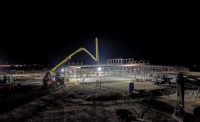...long-lead-time items that had to be ordered well in advance, including the steel, gold-painted domes that adorn the mosques, which were ordered from Campbellsville Industries in Kentucky, Jones says.


Fort Hood is nicknamed “The Great Place” because of its reputation for one of the highest quality-of-life standards in the Army. Consequently, construction is continuous as facilities are constructed or renovated to meet the needs of soldiers and their families, Parker says.
He says that the U.S. Army’s Military Construction program, known as MILCON, is a five-year programming cycle. “From the time the installation says it has a need and sends it to Congress, it is generally five years before the money is appropriated,” Parker says.
USACE uses an assortment of contract vehicles to deliver the huge amounts of work under MILCON, Parker says. “Generally, the procurement strategy is determined at the district level,” he adds. “What happens is that the Corps of Engineers offices and the local contracting community become specialists in building certain types of facilities. That translates into cost savings for the government.”
The combined military construction and operating and maintenance army budget at Fort Hood is $85.2 million for fiscal year 2009, $275.9 million for FY 2010 and $222.8 for FY 2011. Current active projects include a Women’s Health Services building; sitework for unit operations and motor pool; unit operations facilities; barracks complexes; dining hall; upgrade to central energy plant; aircraft maintenance hangar; chapel complex and religious education facility; Warrior in Transition unit; child-development center; restoration of motor pools.
Au Authum Ki Inc. of Chandler, Ariz., is constructing a $10.8-million dining facility that is scheduled for completion in May. The 25,000-sq-ft dining facility—part of a barracks construction project being delivered under several contracts—will serve 1,300 troops and will seek LEED-silver certification.
Jose Lopez, Au Authum Ki project manager, says the foundation is concrete piers, floor beams and floor, and the structure is steel with masonry and exterior brick and stucco veneer. Au Authum Ki is is also building dining facilities for the U.S. Army at Fort Bliss in El Paso and nearby White Sands, N.M., to meet the same level of LEED criteria, Lopez says.
The dining facilities include high-level-technology kitchen equipment and energy efficiency features, including the building envelope, plumbing, electrical and HVAC. “We went above and beyond to make sure the equipment is efficient,” Lopez says. “They have controls to minimize down times so they can save energy in the long run and the equipment can last longer.”
Au Authum Ki’s contract at Fort Hood is design-build, which Lopez says “eliminated a lot of the typical, unforeseen construction issues and surprises. We were working with the designers, contractors and end user. There was a lot of coordination.”
Writer/editor note: Texas Construction offers its deepest sympathy to the families of those who were injured or killed in a shooting on the base on November 5 as this issue went to press. At the time, we were uncertain of the scope of the tragedy or how it might affect future operations at Fort Hood.


